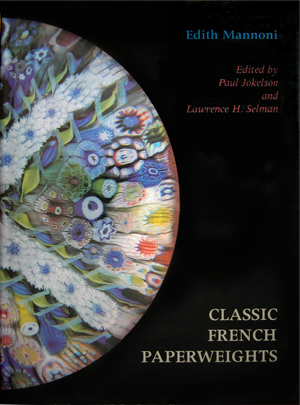Classic French Paperweights
by: Edith Mannoni,
edited by Paul Jokelson and Lawrence H. Selman
1984, Paperweight Press, Santa Cruz, CA
64 pages, $35. hardcover, oversized format
flyleaf: “Paperweights are generally thought of as heavy objects placed on papers to keep them from scattering; but to a paperweight collector, they are works of art with rich simplicity crafted from the beauty and brilliance of glass. It is difficult to imagine that glass paperweights like those illustrated in this book were ever used for such a mundane task as holding down papers. When paperweight production was at its height in the mid nineteenth century, people found these small but intricately fashioned works of art desirable items to be collected and cherished.
Many of the techniques used in the creation of glass paperweights have their origins in ancient Egypt, where the millefiori or “thousand flower” technique was first utilized in mosaics, jewelry, and a variety of functional glass objects. Handed down and improved upon through the ages, this technique reached the height of popularity when European glass factories began encasing millefiori canes, stylized flowers and other elements in clear crystal. These exquisitely designed and finely detailed pieces were first created by French glass factories as examples of the skill and expertise of master craftsmen. It was during the period from about 1840 to 1860 that paperweights became a unique and highly developed art form.
The three prominent glassworks of Baccarat, Clichy and Saint Louis dominated the glass paperweight market of the mid-nineteenth century. Their histories are chronicled in these pages and will give the reader a better understanding of their development. The multitude of color illustrations will help the reader better appreciate the everlasting beauty created by these nineteenth-century glass masters of France.”
This oversized book, originally published in French, has large beautiful illustrations of many fine classic period paperweights and related objects. The history of the three major French factories is well covered here.

